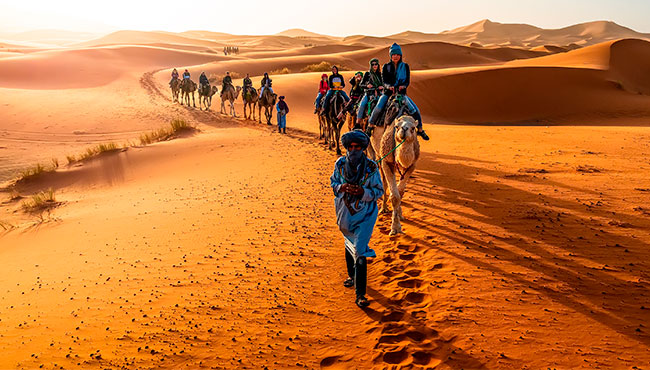The Moroccan Western Sahara is a region of breathtaking landscapes, rich cultural heritage, and warm hospitality. Located in the southern part of Morocco, this area offers travelers a unique blend of desert beauty and coastal charm. Whether you’re seeking adventure in the Sahara or a peaceful retreat by the Atlantic, the cities of the Moroccan Western Sahara have something special to offer.
Laayoune: The Heart of the Moroccan Sahara
Laayoune, the largest city in the Moroccan Western Sahara, serves as the gateway to the region. Known for its vibrant atmosphere and modern amenities, Laayoune is a bustling city where traditional Sahrawi culture meets contemporary Moroccan life.
What to See and Do:
- Place Mechouar: This central square is the perfect starting point for exploring Laayoune. Surrounded by cafes, shops, and government buildings, it’s a great place to soak in the local ambiance.
- Laayoune Beach: Just a short drive from the city center, Laayoune Beach offers a peaceful escape by the Atlantic Ocean. Enjoy a leisurely walk along the shoreline or relax with a picnic while taking in the stunning views.
- Sahrawi Cultural Museum: To gain insight into the local culture, visit the Sahrawi Cultural Museum. The museum showcases traditional crafts, clothing, and artifacts, offering a glimpse into the rich heritage of the Sahrawi people.
Travel Tip: Laayoune is well-connected by road and air, making it an accessible destination for travelers. The city is also known for its welcoming locals, so don’t hesitate to strike up a conversation and learn more about the area.
Dakhla: A Coastal Paradise
Dakhla, located on a narrow peninsula jutting into the Atlantic, is a haven for water sports enthusiasts and nature lovers alike. With its pristine beaches, crystal-clear waters, and constant winds, Dakhla has become a world-renowned destination for kitesurfing and windsurfing.
What to See and Do:
- Dakhla Lagoon: The lagoon is the main attraction in Dakhla, offering ideal conditions for water sports. Whether you’re a seasoned kitesurfer or a beginner, the lagoon’s calm waters and steady winds make it a perfect spot to ride the waves.
- Dragon Island: Take a boat trip to Dragon Island, a small, uninhabited island in the middle of the lagoon. It’s a great place to unwind, explore, and enjoy the untouched natural beauty.
- White Dune: For a truly unique experience, visit the White Dune, a striking sand formation that rises out of the lagoon. The views from the top are spectacular, and it’s a favorite spot for photography.
Travel Tip: Dakhla is known for its seafood, so be sure to sample some fresh fish or try the local specialty, grilled octopus, at one of the many seaside restaurants.
Smara: The Spiritual Heartland
Smara is a city steeped in history and spirituality. Founded in the early 20th century, it has long been a center of learning and religious devotion in the region. Today, Smara offers a more tranquil and reflective travel experience, with its historic sites and serene desert surroundings.
What to See and Do:
- Zawiya of Sheikh Ma El Ainin: This religious complex is one of the most significant sites in Smara. It was founded by Sheikh Ma El Ainin, a prominent figure in the region’s history. The zawiya remains a place of pilgrimage and is an important center of Islamic learning.
- Smara’s Desert Landscapes: The city is surrounded by the vast expanse of the Sahara Desert. Take a guided tour into the desert to experience the stunning landscapes, from rolling dunes to rocky plateaus, and witness the breathtaking beauty of the Sahara.
Travel Tip: Smara is less touristy than Laayoune and Dakhla, offering a more authentic and quiet experience. It’s a great place to connect with the local culture and history away from the crowds.
Tarfaya: A Coastal Gem with a Rich History
Tarfaya, a small coastal town, is known for its historical significance and picturesque views of the Atlantic. It’s a perfect stop for those interested in the history of exploration and maritime heritage.
What to See and Do:
- Cape Juby: Tarfaya is home to the historic Cape Juby, once a critical stop for airmail pilots crossing the Sahara. The remains of the old fort and the monument to Antoine de Saint-Exupéry, the famous French writer and aviator, are must-see landmarks.
- Tarfaya Beach: The town’s beach offers a tranquil setting for relaxation. The views of the Atlantic are stunning, especially at sunset, making it a great spot for photography.
- Colonial-Era Architecture: Stroll through Tarfaya to see remnants of its colonial past, including old buildings and monuments that tell the story of its rich history.
Travel Tip: Tarfaya is quieter and less commercialized than other coastal towns, making it ideal for those seeking a peaceful retreat.
Travel Tips for the Moroccan Western Sahara
- Best Time to Visit: The Moroccan Western Sahara enjoys a mild climate year-round, but the best time to visit is during the cooler months from October to April.
- Getting Around: The region is well-connected by a network of roads, and rental cars are available in major cities like Laayoune and Dakhla. There are also domestic flights between cities for those looking to travel quickly.
- Cultural Etiquette: The Moroccan Western Sahara is known for its hospitality. Visitors should dress modestly and respect local customs, especially in more traditional areas like Smara.
- Accommodation: From luxury resorts in Dakhla to guesthouses in Smara, there are accommodation options to suit every budget. It’s recommended to book in advance, especially during peak travel seasons.
Conclusion
The Moroccan Western Sahara is a region of incredible diversity and beauty, offering travelers a unique experience that combines the best of Morocco’s desert landscapes and coastal charms. Whether you’re seeking adventure, culture, or simply a place to unwind, the cities of Laayoune, Dakhla, Smara, and Tarfaya are waiting to be explored. Embark on a journey to discover the hidden gems of the Moroccan Western Sahara, where every corner has a story to tell.

